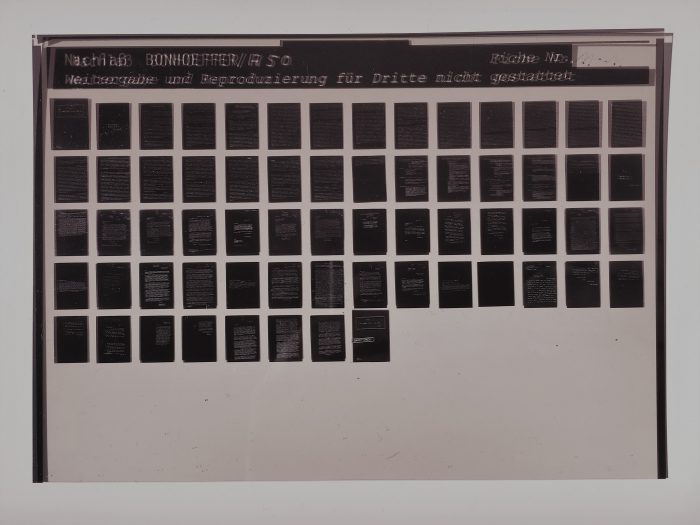“Microfiche is cool” is a sentence one rarely hears any more, in the Internet age. Yet I am constantly reminded of the astonishing efficiency of microformatting, when researchers ask to see the collection of primary-source materials of Dietrich Bonhoeffer—noted German theologian, pastor, and anti-Nazi dissident, and onetime student at Union Theological Seminary—preserved on microfiche, collectively known as the Nachlaß (“Nachlass,” or Estate) collection. This microfiche collection is decidedly cool—so much so, in fact, that we decided to create an entire exhibit about it.
The Nachlaß includes many of Bonhoeffer’s early writings and personal papers, his research notes, and letters from prison. Most of Bonhoeffer’s original manuscripts and papers have been preserved in the Staatsbibliothek zu Berlin, with some primary documents in English kept here at the archives of the Burke Library at Union Theological Seminary. These two libraries possess the only two known copies of the complete Nachlaß microfiche collection in the world (that our staff is aware of), making this collection both unique and invaluable to researchers. Each “twin set” of microfiche contains an enormous quantity of material: several thousand fragile documents, condensed into a breadbox-sized collection of roughly 300 plastic fiche cards. The Nachlaß is one of the most frequently-used microfiche collections at the Burke Library.

What is microfiche, exactly? (Those who have always lived in the same world as the Internet, after all, might never have heard of it before.) Well, microform technology—including microfiche cards and microfilm reels—originated in the early 1800s with the advent of photography. It became widely popular in libraries and archives in the mid-20th century as a reproduction and preservation medium (before the days of Internet digitization and online exhibits). Documents are photographed and printed as tiny images, which can then be inserted in a reader machine and enlarged on large reader screens, allowing readers to view and skim materials at a relatively fast pace. Microform plastic is sturdy, durable, and highly portable (think: a single plastic fiche card containing 80 document images, compared to a folder of 80 loose sheets of paper). Images of documents on microfiche can be seen by a large audience, while the original fragile documents are kept in archival storage. Microfiche was one of the original digital media! Thousands of printed books and journals have been microformatted, as have several rare manuscripts and primary-source collections—such as the Bonhoeffer Nachlaß.
Collecting and preserving Dietrich Bonhoeffer’s papers and creating the Nachlaß collection was a monumental undertaking. Following Bonhoeffer’s death in 1944, his letters and documents were meticulously collected by his close friend Eberhard Bethge, in collaboration with the Bonhoeffer family. Bethge devoted much of his life to editing and publishing Bonhoeffer’s works, such as the Letters and Papers from Prison and Ethics, and wrote the first biography of his professor, Dietrich Bonhoeffer: Man of Vision, Man of Courage in 1967. Amidst the subsequent surge of interest in Bonhoeffer, it was Bethge, along with his colleague Dietrich Meyer, who spearheaded the idea of creating a microfiche collection of Bonhoeffer’s papers, for use at “various Bonhoeffer research centers” in the 1980s. The Burke Library acquired the microfiche collection with the facilitation of Professor Clifford Green, Bonhoeffer Chair Scholar at Union Theological Seminary, and former Burke Library archive specialist Ruth Cameron. Now researchers can have eyes on original primary-source documents, written in Bonhoeffer’s own hand, via the microfiche copies, while the originals are housed in storage.

Our newest exhibit showcases some rarely-seen materials from Bonhoeffer’s days as a student at Union Theological Seminary in the early-1930s, such as the above image of handwritten notes Bonhoeffer took in a “Religion and Ethics” course taught by Reinhold Niebuhr, enlarged and printed from Nachlaß microfiche onto plain 8.5 by 11 inch white paper. This medium reflects the mode in which researchers view microformatted primary-source materials today, and we hope this exhibit raises questions and curiosity about accessibility, duplication, and preservation in the 20th century and the Internet era.

The original documents are housed in the Dietrich Bonhoeffer Primary Sources collection in the Burke Library Archives. The exhibit is currently on view at the Burke Library at Union Theological Seminary, 3041 Broadway, on the ground floor (Level L1) exhibit space. It will be on view through January 2020.